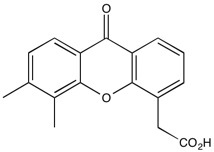DMXAA | STING agonist
NMR (Conforms)

Available Options
| Size: | Price | Quantity | |
|---|---|---|---|
| 5 mg | $60.00 | ||
| 25 mg | $240.00 |
DMXAA (117570-53-3) is a STING (Stimulator of Interferon Genes) agonist selective for mouse STING.1,2 Intratumoral administration of DMXAA resulted in tumor regression and complete rejection in mouse xenografts.3 Tumor regression induced by DMXAA results from a cascade of cellular events which include disruption of tumor vasculature followed by the release of chemokines which trigger the recruitment of immune cells.4 DMXAA induced expression of IFN-β resulting in a striking expansion of leukemia-specific T cells extending survival in two acute myeloid leukemia models.5
References/Citations:
1) Prantner et al. (2012), 5,6-Dimethylzanthenone-4-acetic acid (DMXAA) activates stimulator of interferon gene (STING)-dependent innate immune pathways and is regulated by mitochondrial membrane potential; J. Biol. Chem., 287 39776
2) Conlon et al. (2013), Mouse, but not human STING, binds and signals in response to the vascular disrupting agent 5,6-dimethylxanthenone-4-acetic acid; J. Immunol., 190 5216
3) Corrales et al. (2015), Direct Activation of STING in the Tumor Microenvironment Leads to Potent and Systemic Tumor Regression and immunity; Cell Rep., 11 1018
4) Weiss et al. (2017), The STING agonist DMXAA triggers a cooperation between T lymphocytes and myeloid cells that leads to tumor regression; Oncoimmunology, 6 e1346765
5) Curran et al. (2016), STING Pathway Activation Stimulates Potent Immunity Against Acute Myeloid Leukemia; Cell Rep., 15 2357
NMR (Conforms)
Safety Data Sheet:
Product Data Sheet:
Materials provided by Focus Biomolecules are for laboratory research use only and are not intended for human or veterinary applications. Please note that we do not sell to individuals and that all orders placed by non-research organizations will incur a $20 restocking/refund fee
DMXAA (117570-53-3) is a STING (Stimulator of Interferon Genes) agonist selective for mouse STING.1,2 Intratumoral administration of DMXAA resulted in tumor regression and complete rejection in mouse xenografts.3 Tumor regression induced by DMXAA results from a cascade of cellular events which include disruption of tumor vasculature followed by the release of chemokines which trigger the recruitment of immune cells.4 DMXAA induced expression of IFN-β resulting in a striking expansion of leukemia-specific T cells extending survival in two acute myeloid leukemia models.5
References/Citations:
1) Prantner et al. (2012), 5,6-Dimethylzanthenone-4-acetic acid (DMXAA) activates stimulator of interferon gene (STING)-dependent innate immune pathways and is regulated by mitochondrial membrane potential; J. Biol. Chem., 287 39776
2) Conlon et al. (2013), Mouse, but not human STING, binds and signals in response to the vascular disrupting agent 5,6-dimethylxanthenone-4-acetic acid; J. Immunol., 190 5216
3) Corrales et al. (2015), Direct Activation of STING in the Tumor Microenvironment Leads to Potent and Systemic Tumor Regression and immunity; Cell Rep., 11 1018
4) Weiss et al. (2017), The STING agonist DMXAA triggers a cooperation between T lymphocytes and myeloid cells that leads to tumor regression; Oncoimmunology, 6 e1346765
5) Curran et al. (2016), STING Pathway Activation Stimulates Potent Immunity Against Acute Myeloid Leukemia; Cell Rep., 15 2357
Related STING Products
Download
Calculate the molar concentration, mass or volume in a solution.
Concentration × Volume × Molecular Weight = Mass
Focus Biomolecules • Plymouth Meeting, PA USA • 1-855-FOCUS21
Focus Biomolecules
Plymouth Meeting, PA USA
1-855-FOCUS21
Website Created by Advanta Advertising LLC.

